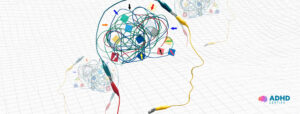ADHD is rarely a solo act. While most people consider it a simple case of inattention or fidgeting, the reality is far messier. What is ADHD really? goes deeper into how the condition manifests beyond stereotypes. Studies show that up to 90% of individuals diagnosed with Attention-Deficit/Hyperactivity Disorder also live with at least one other mental health condition. Often, it’s not just ADHD, it’s ADHD and anxiety. Or depression. Or a learning disorder. Or something else entirely.
This overlap isn’t just a footnote; it’s the rule, not the exception. And when conditions stack up, so do the complications, misdiagnoses, failed treatments, school struggles, strained relationships, and a quiet, persistent sense that something important is being missed.
In this piece, we’re not just talking about ADHD. We’re looking at what happens when ADHD brings friends how comorbidities form, how they tangle with one another, and, most importantly, how people can navigate this complexity with clarity, compassion and the proper support.
What Comorbidity Actually Means (and Why It Matters)
‘Comorbidity’ might sound like medical jargon, but the idea is simple: it means having more than one condition at the same time. For people with ADHD, that’s not just common, it’s the norm.
Researchers estimate that around 60% to 90% of individuals with ADHD also live with other psychological or developmental conditions. Sometimes that means anxiety. Sometimes it’s a mood disorder, a learning disability, or even all three. Each added condition introduces new symptoms, more confusion, and often more frustration.
What makes these overlaps especially tricky is that the root causes are often shared. Genetics, early life trauma, chronic stress, inflammation these aren’t issues that isolate themselves neatly. They ripple through development, often triggering a cascade effect that shapes not just attention and behaviour, but emotional wellbeing, cognition, and even physical health.
Why does this matter? Because treating ADHD in a vacuum with a one-size-fits-all solution rarely works when the full picture is more crowded. The real challenge and opportunity lies in seeing the whole person, not just their most obvious symptoms.
Diagnostic Crossroads: Why It’s Hard to Tell What’s What
Spotting ADHD is one thing. Spotting ADHD when it’s tangled up with depression or anxiety? That’s something else entirely.
Many of the symptoms overlap. Is someone struggling to focus because of ADHD? Or because they’re gripped by anxiety that won’t let their mind settle? Is their restlessness a sign of hyperactivity or the physical fallout of constant worry? And when someone’s lashing out or shutting down emotionally, are we seeing impulsivity, mood instability, trauma responses or a messy mix of all three?
This is where diagnoses can fall short. If a clinician only sees part of the picture or if the individual masks certain traits they may miss key components of what’s really going on. And when a condition goes unrecognised, so do opportunities for effective support.
To make matters even more complex, ADHD rarely looks the same from one person to the next. Some are highly impulsive and energetic; others are quietly inattentive and withdrawn. When you throw additional conditions into the mix, the presentation becomes even more individualised. That’s why detailed assessments, broad clinical interviews, and listening to the voices of parents, teachers, or partners can be vital. No one symptom exists in isolation and neither should the diagnosis.
The Usual Suspects: Conditions That Commonly Coexist with ADHD
Cortical Wiring Issues
Some co-occurring conditions stem from the brain’s structural development of what might be called cortical wiring differences. These aren’t emotional disorders or behavioural reactions; they’re hardwired traits that influence how someone processes language, movement, and information.
These often include:
- Learning difficulties (e.g. dyslexia, dyscalculia)
- Language processing issues
- Motor coordination challenges
- Executive dysfunction (problems with planning, memory, organisation)
Crucially, these aren’t problems that medication alone can fix. They often require tailored academic support, therapeutic interventions, and patient, ongoing adjustments in the school or work environment. Without this support, even the brightest individuals may feel like they’re constantly falling short, not because they lack ability, but because the system wasn’t built for their brain.
Emotional and Behavioural Co-Conditions
Then there’s the emotional side conditions that directly affect mood, stress response, and social behaviour. These include:
- Anxiety disorders
- Depression
- Oppositional defiant disorder (ODD)
- Conduct disorders
People with ADHD are far more likely to develop depression and anxiety some studies suggest five times more likely for depression and four times more likely for anxiety. These aren’t just side effects of ADHD; they’re often fueled by the daily frustration, shame, and rejection that can come from struggling to meet expectations, especially without understanding why.
The behavioural piece is just as complicated. A child who seems defiant may be overwhelmed. An adult who loses their temper may be fighting executive overload, not a temper problem. Labels don’t always help. Understanding does.
The ADHD Anxiety Depression Triangle
This trio of ADHD, anxiety and depression is one of the most tangled combinations in mental health.
Each one can mimic the others. A depressed person may seem inattentive. An anxious person may look hyperactive. An ADHDer may appear emotionally flat because they’re overwhelmed and masking. And because these conditions often interact and fuel one another, it’s hard to tell which came first.
What’s clear is that left untreated, they form a feedback loop. ADHD leads to stress, which triggers anxiety, which leads to underachievement, which fuels depression, which then magnifies ADHD symptoms. Round and round it goes. Breaking the cycle takes more than a diagnosis. It takes strategy, self-awareness, and ongoing support.

How Comorbid ADHD Disrupts Daily Life
School and Work
When ADHD is paired with another condition, the effects on academic and professional life can be profound. Missed deadlines. Incomplete tasks. Constantly feeling behind, no matter how much effort is put in.
For students, that might mean constant detentions, misunderstood meltdowns, or feeling alienated from classmates. For adults, it often translates into job-hopping, burnout, or career ceilings that don’t match their potential. It’s not a lack of intelligence. It’s a mismatch between the brain’s wiring and the world’s demands.
Relationships and Social Dynamics
Friendships, romantic relationships, and even interactions with strangers all can become fraught when emotional regulation is off-balance.
An ADHDer might interrupt too often, say the wrong thing at the wrong time, or seem emotionally volatile. Add in anxiety, and they may pull away from others entirely. Add depression, and they may struggle to connect at all. The result? Loneliness. Misunderstanding. Shame.
Understanding that these aren’t personality flaws but symptoms of complex conditions is the first step toward repair and relief.
Self-Esteem and Identity
Many people with ADHD and comorbid conditions carry a deep, private ache: the belief that they’re fundamentally broken.
Years of missed opportunities, social failures, or being labelled as lazy or difficult can erode confidence to the point where even praise feels fake. What makes this worse is that these individuals are often highly aware of their own struggles but not always sure how to explain them or how to fix them.
Therapy can help. So can the community. But above all, a reframing of the narrative is needed from “I’m not enough” to “I’ve been navigating a brain that works differently and it’s time I learned how to work with it.”
Treatment That Actually Works: A Multimodal Playbook
Medication (But Not Just That)
For many, medication is a vital piece of the puzzle. Stimulants, antidepressants, or anti-anxiety meds can help regulate the chemical chaos, but they’re rarely the full story.
Some medications can target multiple issues at once; others need to be combined. What’s essential is having a prescribing clinician who understands the overlap and who doesn’t treat ADHD as a one-medication-fits-all condition.
Therapy and Coaching
Cognitive behavioural therapy (CBT) is a strong ally, especially when anxiety or depression is in play. ADHD coaching, too, has gained traction helping people develop realistic systems, habits, and routines that support how they function, not how the world expects them to.
For children, behavioural interventions at home and school can dramatically reduce oppositional behaviours and emotional flare-ups. The key is consistency and a non-punitive approach rooted in understanding, not judgment.
Lifestyle Tweaks That Stick
Nutrition, exercise, sleep none of these are cures, but all of them are levers. Movement boosts dopamine. Balanced meals stabilise mood and energy. Sleep gives the brain space to recharge and regulate.
It’s not about perfection, it’s about building rhythms that work, bit by bit. Even small adjustments can create ripple effects across mood, focus, and resilience.
Holistic Management: Early Action, Better Outcomes
Early Identification and Intervention
Spotting ADHD and its tagalongs early gives individuals the best chance to thrive. The longer conditions go unrecognised, the more layered and entrenched their effects become.
Parents, teachers, and GPs should be especially alert during developmental transitions starting school, puberty, first jobs, when new symptoms often surface.
Comprehensive Assessment
The gold standard for diagnosis? A wide-angle lens. This means clinical interviews, input from family or educators, questionnaires, cognitive testing and a careful look at developmental history.
Only with a full picture can professionals distinguish between ADHD, trauma responses, mood disorders, and other possible explanations.
Personalised Treatment Plans
One-size-fits-all doesn’t work here. Treatment must account for:
- The specific conditions present
- Their severity and how they interact
- The person’s age and life context
- Their values, goals, and personal strengths
This approach takes more time. But it’s the only route that leads to meaningful, lasting change.
Conclusion
Living with ADHD, especially when it comes bundled with other conditions, is complex. But complexity isn’t chaos. It’s a signal that a more nuanced, layered approach is needed.
With the right tools, the right professionals, and the right perspective, individuals with ADHD and comorbidities can not only function, they can flourish. The process may be slower than expected. Progress may be uneven. But progress is possible.
Because it’s not just about managing symptoms, it’s about understanding the self with all its brilliant, bewildering intricacies and building a life that fits.
Frequently Asked Questions
What does it actually mean when ADHD has comorbid conditions?
When someone has ADHD and another condition (like anxiety, depression, or a learning disability), that’s what clinicians refer to as a comorbid condition. It’s not unusual — in fact, research suggests up to 90% of people with ADHD have at least one additional mental health or developmental diagnosis. These coexisting conditions often interact in complex ways, making symptoms harder to isolate or treat individually.
Need help figuring out your full diagnostic picture? Book a comprehensive ADHD & comorbidity assessment with our clinical team.
Could my ADHD have been misdiagnosed — or is something else also going on?
Absolutely. ADHD often shares symptoms with anxiety, depression, bipolar disorder, and trauma-related disorders. For instance, someone with depression might struggle to concentrate, appear unmotivated, and withdraw — all of which could be mistaken for inattentive ADHD.
This is why misdiagnosis is common, particularly when clinicians don’t screen for comorbidities.
If your current treatment isn’t helping, there may be more going on. Get matched with a clinician who specialises in complex ADHD cases.
I was diagnosed with ADHD, should I be screened for other conditions too?
Yes. If you’ve been diagnosed with ADHD, there’s a very strong chance you’re also managing other conditions — whether you realise it or not. Many adults with ADHD aren’t screened for mood disorders, trauma histories, learning disabilities, or executive function disorders, which delays appropriate treatment.
A full diagnostic screen can be life-changing, especially if your current strategies aren’t working.
Schedule a full-spectrum mental health assessment here.
How do I know if my focus issues are from ADHD or something else like anxiety or depression?
That’s one of the most common — and difficult — questions. ADHD-related inattention usually shows up as mind-wandering, impulsivity, or distractibility, while anxiety-related inattention often stems from overthinking, hypervigilance, or rumination. Depression might make it feel like you can’t even start the task.
A proper differential diagnosis involves looking at context, history, emotional patterns, and physical symptoms.
My ADHD medication isn’t working, could I have other conditions too?
Yes — and this is surprisingly common. Stimulant medications, while often helpful for core ADHD symptoms, may not touch the underlying emotional dysregulation, anxiety, or trauma that’s also in play. In fact, untreated comorbid conditions can make meds feel ineffective or even worsen symptoms like irritability or insomnia.
Why does ADHD make relationships so hard, especially with emotional regulation?
People with ADHD often struggle with impulsivity, rejection sensitivity, and emotional reactivity. Add in depression, anxiety, or trauma histories, and it can feel like you’re constantly apologising or misunderstood. This dynamic affects romantic relationships, friendships, and family roles.
My child has ADHD but is still struggling in school — what else could be happening?
If your child is still having a hard time despite medication, it’s likely that ADHD is only part of the picture. Many children also experience learning differences (dyslexia, dysgraphia), sensory processing issues, or executive function challenges. These require specific interventions and school support, not just medication.
Can untreated ADHD cause anxiety or depression later in life?
Yes, and this pattern is well-documented. When ADHD isn’t identified or managed early, the cumulative stress of underachievement, social isolation, and internalised shame can lead to anxiety and depression. In turn, these conditions often worsen ADHD symptoms, creating a vicious cycle.




